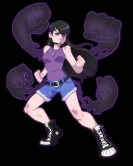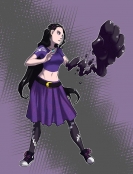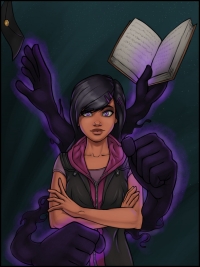The foundations of the MCO belong ultimately in examples set by groups such as the Bavarian Illuminati, the Rosicrucians, Anarchist Insurrectionists, the Ku Klux Klan, European gangs, and Chinese Tongs. However, the true beginnings can be found in the back alleys of the Intelligence War fought during World War One. While the seminal image of WWI is, of course, the horrific meat-grinder of men that was trench warfare during the Battles of the Marne and the Somme, there were other fronts as well. Besides the equally harsh Eastern Front, there was a lively war of espionage that was fought between the Intelligence services of the Central and Alliance power. Before WWI, Intelligence and Espionage had, ironically, been a gentleman's game played by professional diplomats. However, with the phenomenal increase of speed in both transportation and communications, the leisurely pace and genteel discretion of Intelligence work was abandoned for a more workmanlike, 'whatever gets the job done' approach. So, professional criminals, con artists, demimondaines, forgers, pickpockets, smugglers, burglars, contraband merchants, and even common thugs were drawn into subtle and often very lucrative world of international diplomacy, espionage and intrigue. Those who learned the ways of cloak & dagger profited greatly- those who bungled their lessons died. Foremost of these criminal opportunists plying the WWI Intrigue trade was Sir Simon DeVille, British swindler, forger, smuggler, blackmailer and all-around Upper-Crust Cad.
After the Armistice, the underworld fondly remembered those salad days, when the knowledge of a single piece of choice information could make you rich. Never ones to forgo a market that had proven lucrative, criminals set about restoring the shadowy world of intrigue in postwar Europe. Crime syndicates became more sophisticated than police departments were capable of keeping up with. Fringe political movements, such as the Socialist, Fascist, Technocrat, and others moved into this new social medium, and they both exploited each other. Added to this mix were the myriad 'Mystic Lodges' that explored the boundaries of the Occult with little regard for the Law or the safety of others. The call for covert operatives was so high, that in 1921, Sir Simon DeVille opened the DeVille Academy in Lucerne, Switzerland, which trained gutter urchins from around Europe (and later the Globe) in the fine art of Espionage and Covert Operations. In Asia, the various Triads saw their opportunity to be rid of the intrusive Colonial powers, and sent out waves of 'Sinister Asiatic Masterminds' to attack the Europeans on their own ground. While at first there was a certain degree of 'churn', of movement and daring-do for its own sake, eventually this garden of malice sent forth its most malignant blossom: the Nazi Party.
When the Nazis weaseled their way into power in Germany, the rest of the Shadow World just kept going on as usual- at first. But as Fascism became the predominant power on the Continent, the various factions and syndicates and players began choosing sides. When the German War Machine began the first steps of its deadly war dance, it was only too happy to use the various syndicates as pawns. However, the spy masters of the Reich knew the syndicates far too well to really trust them, and developed their own covert operations organs that were loyal to Germany beyond the next pay envelope. While the Germans loved to present a monolithic picture of solidarity, the truth was that the Third Reich was hideously factionalist and rivalry-prone. Almost every branch conceivable of the Nazi power elite had its own Intelligence and Covert Operations arm. While the Abwher was the official Military Intelligence and Covert Operations organ, the SS, the Gestapo, the Heer (German Army), the Luftwaffe, the Foreign Office, and even various German industries such as Krupp and IG Farben, all had their own covert operations branches. These rival spy networks competed vigorously for coups and master strokes, which sometimes achieved great things, but more often simply operated at cross-purposes. However, it did have the advantages of providing cross-referencing, and that if one agent or cell was compromised, its rivals in that area would still be in place.
Hitler and the Nazi elite placed a lot of confidence in German's ability to create 'Wonder Weapons'. As a result, the Nazis recruited legions of scientists and engineers who could generously be called 'eccentric'. Many of their efforts- the Flying Swastika, the Thunder Cannon, the Iron Giant, or the Zombie Legions- were impressive and terrifying, but not tactically practical. Still, the most impressive of the 'wonder weapons' were the 'Thema-Agenta' or 'Theme Agents', known to the West simply as 'Nazi Supervillains'. The Theme Agents, fell into three basic categories: the 'Volkshelden', who were Germany's response to America, Britain and France's 'Flag Heroes', were the 'showcase heroes' who appealed to German patriotism, or confirmed various notions of Nazi philosophy, mysticism or propaganda. Almost an antithesis of the Volkshelden where the Angsthandlers, or 'Fear Mongers'. The Nazis, Hitler especially, were firm believers in the use of Terror as a weapon. The Angsthandlers were deformed, monstrous and fearsome. Their job was to demoralize subject peoples, resistance groups and enemy troops wherever and whenever they could. The last, least visually impressive group of the three was the Schattenherren, or 'Shadow Lords'. While not as powerful or impressive as either the Volkshelden or the Angsthandlers, the Schattenherren had abilities that were better suited for the subtle work of espionage and sabotage. All three groups were mostly created by the aforementioned 'Eccentric' Scientists, who were all looking for ways of creating the Ubermensch. Even Hitler realized that their bizarre prodding into the barely understood was hideously dangerous. However, he also had thousands of young German men and women who, while eager to serve the Reich, were far from physically fit to serve in the Wehrmacht. He had even more young NON-German men and women who were far from eager to serve the Reich in ANY way, but who were regarded as expendable. It is estimated that 170,000 'enemies of the Reich' and 15,000 German youths were killed in the experiments that produced the 250 'Theme Agents'.
The Theme Agents served with distinction in WWII- by Nazi standards. By Allied standards, they were War Criminals. When the Reich finally collapsed, a few of the Theme Agents (mostly Volkshelden, who could blend back into the German population by simply shedding their costumes) tried to put their wartime activities behind them and get on with their lives. But most of the Theme Agents- especially the Angsthandlers, who had become monsters, even in their own eyes- were deeply embittered by their loss, and swore blood oaths to bring about a Fourth Reich. The Theme Agents joined forces with the Mad Scientists who created them and the various Nazi covert operations organs, and fled across the globe, with the intent of seeding new Nazi movements in South America, the Middle East, China and Africa. Some of the more fanatic Theme Agents carried on campaigns of retribution against France, Britain, Canada and the United States. Please note that even the fanatics didn't try this in the Soviet Union.
While it was rather low-key in the immediate post-war era, the Cold War developed into a bizarre three-way shadow war between NATO, the Warsaw Pact and the shadowy Fourth Reich. The 1950s were a golden age for non-partisan mercenary Espionage/ Covert Operations/ Terror/ Crime networks that played the three major players against each other. The war had created small armies of hardened veterans of both regular and irregular combat, who were either unwilling, or incapable for thousands of reasons, of returning to normal civilian life. These hard men and women filled the ranks of almost anyone who was willing to give them a cause, a weapon and a paycheck. Sir Simon DeVille's Academy provided the Criminal Spy Syndicates with the sleek, attractive, sophisticated, highly skilled and utterly ruthless special operatives that were the trademark of this period. There was a fashion during the era for these shadow nations to adopt acronym titles that spelled out fearsome names: HADES, FENRIR, TAROT, and so on. The Sinister Asiatic Masterminds managed to hold on, despite being caught between the West, the Communists and the Japanese during WWII. However, in 1958, the Network, a criminal espionage syndicate that Ian Fleming immortalized as 'SPECTRE' pulled off the operation that Fleming described in 'Thunderball'. While the hijacked nuclear warheads were recovered, the world leaderships were made painfully aware that their third-hand pawns had developed motives and agendas of their own, and would not be easily controlled. Worse, the Fourth Reich movements, as well as a few of the surviving Technocracy organizations had settled on a very disturbing strategy- repeatedly, they tried to trigger incidents that they hoped would escalate into World War III, with the East and the West destroying each other with atomic weapons. They planned to emerge from the rubble as the forces with the manpower, equipment and resources to build and take over the world.
While the 'Thunderball' incident was never officially confirmed, the UN and various national governments responded by forming batteries of 'super-spy agencies' to deal with the threat. These new 'spy' agencies fielded small but very effective forces of highly trained operatives with an amazing array of special gadgets and weapons, that operated without a lot of in-field oversight or review. Some of these agencies recruited and trained, or even created paranormally empowered agents using technologies acquired from captured 'Mad Scientists'. While these 'super-spy agencies' were hideously unpopular with their more conventional counterparts in the Law Enforcement and Intelligence communities, they were very effective in knocking out the 'Shadow Nations' one at a time. Also, there was the fact that the technology that helped create and nurture the Shadow Nations was turning against them. Satellite communications and jet travel shrank the globe to the point where it got harder and harder to build a secret base.
However, the most effective measure against the Criminal Espionage Networks came from a very unlikely source- the Movie industry. Sir William Stephenson, a.k.a. 'The Man called Intrepid', prompted movie moguls Saltzman and Broccoli to film a version of Ian Fleming's Dr. No, as a way of 'outing' the Network, and by extension, the other Criminal Spy Networks. Dr. No and the successive 007 movies were surprise box office smashes. The Bond movies and the slew of other 'Super-Spy' movies of the mid-60s dampened criticism of the 'Super-Spy' agencies and did something to the Criminal Spy Networks that they still haven't recovered from- they made them ridiculous. It's hard to be really intimidated by HADES or TAROT, when you can see an idiot like Maxwell Smart beating the cream cheese out of KAOS on TV every week. Besides costing them their sinister glamour, the Spy movies wore at the Criminal Spy Networks' morale. Seeing dozens of guys doing basically your job being casually dealt with by a single agent like that will get you down after a while.
Between the 'Super-Spy' agencies' successes, the changes in the technology and the political climate, and the increasing level of ridicule, many of the Criminal Spy Networks either lowered their profile greatly or shut down completely. While better funded and more politically secure, the Nazi Fourth Reich movements were also suffering. The expected resurrection of a Nazi state never materialized, and scientists became aware that an all-out nuclear exchange would result in a Nuclear Winter that would devastate the entire world, not just the target nations. The Nazi and Technocrat leaderships came to the bitter realization that their grand strategy was ultimately suicidal.
However, in 1962 there was a development that didn't cause a lot of waves at the time, but lead to far greater consequences. Biologist Stanley Leiber published his 'Report on the Impact of Aberrant Genetic Mutations on the Development of Paranormal Abilities'. The Leiber Report was the first scientific confirmation that that roughly 20% of the operative super-humans on the planet gained their powers from a genetic mutation, rather than from any external source. The Leiber Report was a calm, scholarly, non-partisan work that made no moral judgements about mutants. The same could NOT be said of a book that it inspired, which came out a year later.
Javier Magnusson's The Next Master Race was a masterpiece of rabble-rousing panic-mongering 'junk science' that crystallized many of the bigoted memes regarding mutants. Magnusson argued that mutants instinctively regarded themselves as a race separate and distinct from baseline humanity. He argued that mutants had subliminally distinct pheromones that alienated mutants from humanity, while predisposing them to other mutants. He argued that the use of mutant powers upset the chemical balance of the brain, causing megalomania, paranoia, outbursts of hysterical violence and psychotic delusions. He held that mutants feel an instinctive socio-biological urge to assert their dominance over baseline humans, whom they implicitly regard as weaker and inferior. He further asserted that mutants were innately more resistant to disease, radiation and toxic chemicals, and hence would regard atomic, biological, and chemical warfare as valid methods of suppressing baseline humans.
The Next Master Race came out less than 20 years after the end of World War II and the Civil Rights movement was under full steam in the United States, so the notion of arrogant, genocide-inclined supermen pushed a LOT of hot buttons. And in the meantime, the Baby Boom generation, bolstered by the antibiotic revolution in Medicine, was causing an unprecedented number of preter-human mutations to survive to manifest their powers in North America and Western Europe. The incredible coincidence of this 'outbreak' of 'mutant monsters' coinciding with the publication of The Next Master Race (or vice-versa) has been hotly debated ever since. While biologists decried the shoddy research of The Next Master Race, it remained on the Best-Seller lists for four years, and Magnusson was a constant presence on the talk show and lecture circuits, promoting his viewpoints until his mysterious disappearance in 1972.
One of the ongoing controversies regarding The Next Master Race is whether it instigated or merely foresaw the rash of 'Mutant Supremacists' that emerged in the mid-1960s. Groups like Blood Legacy, Eugenix, and the Inheritors of the World made repeated attempts to acquire or build atomic, biological or chemical weapons, almost using Magnusson's book as a blueprint. Always ones to seize a new advantage, some of the surviving Criminal Spy Syndicates 'took sides' in the 'Mutant Crisis', either pro-, anti- or neutrally mercenary. This brought the 'Super-Spy' agencies into the conflict, which had a dramatic influence on both sides. The new mutant extremists adopted many of their colleague's ruthless tactics and 'viciousness as a virtue' approach, while the Super-spies tended to see the mutants as merely a new manifestation of the Nazi mentality.
In 1964, the Mutant Commission Office was founded. The MCO was not originally created to be a policing organization. Rather, its original concept was to be a scientific facility researching the nature of mutant traits and psychology, and a clearinghouse for information about mutant powers, side effects, allergic reactions, personalities, tactics, organizations and possible long-term agendas, rather on the INTERPOL model. The MCO was not a branch of the UN, but a subscription organization that by charter had to obey the laws and legal procedures of the country that they were working in. Despite its rather bland concept, the mutant extremists regarded the MCO as a direct threat to them from the very beginning, and MCO researchers and archives were under almost constant attacks. The Super-Spy agencies adopted a 'my enemies' enemy is my ally' tack, and took the MCO under their collective wings.
By 1972, the party was pretty much over for the Super-Spy agencies. Most of the Criminal Spy Syndicates had either been destroyed, or had turned to more low-key endeavors. While there was an outburst of activity from the Sinister Asiatic Mastermind crews, Espionage Historians agree that this was more a 'last gasp' than a renewal. The global economy had hit a downturn, and financiers- both legitimate and criminal- had better things to do with their money than fund outrageous feuds by guys with fancy gadgets. Muslim Terrorists, who eschewed high technology and elaborate plots in favor of more conventional weapons wielded by fanatics, were commanding the world's attention. Also, the Super-Spy agencies had problems of their own. They had ignored Nietszche's warning about those who fight monsters, and had picked up some very nasty habits in the course of their wars with the Shadow Nations. They were used to fighting pitched, no-holds-barred battles with little if any civilian oversight and no personal repercussions for their actions. They were used to having lavish budgets that they weren't called to answer for. They were in many ways as arrogant, reckless and ruthless as the Criminal Spy Syndicates that they fought.
As the Recession of 1970s withered the prosperity of the West, Congress and the American people started questioning the Super-Spies' methods and tactics- and budgets. The more conventional Law Enforcement and Intelligence services took advantage of this to humble the 'Super-Spies' and bring the maverick agencies to heel. While there was no official sit-down meeting over it, the Super-Spies saw this as a bad thing, and sought new avenues of pursuing their careers. As one 'Super-Spy' agency after another came under scrutiny and had its budget trimmed and staff pared, individual agents started quitting and taking jobs elsewhere. Many of them found work with the MCO, where they still had friends whom remembered them from before. The MCO was a private organization with its own sources of funding. The various branches of the MCO became refuges for 'Super-Spies' from all nations and agencies. They even managed to transfer over files and esoteric equipment from their old gigs.
While the Criminal Spy Syndicates were lying low, the Mutant Extremists were vigorously competing with Muslim Terrorists for psychological impact on the world's Media. Though the MCO had no formal police powers, the former 'Super-Spies' arranged to have the MCO 'deputized' on a case-by-case basis to handle crises. As the MCO gained a reputation for being the people who 'handled' out of control mutants, the Super-Spies managed to take control of the MCO itself, turning it from the Research and Information Distributor that it had been into an active policing agency in its own right. The MCO had to negotiate the changes in its charter with each subscriber nation, resulting in the wildly varying scope of powers that the MCO enjoys. The Old School Super-Spies still regarded mutants as de facto Nazis and treated them as such, even as the Fourth Reich organizations still existed, though operating very much underground.
By the 1980s, the Mutant Supremacists were mostly a dead letter. All but the most psychotic of them realized that their mutant powers weren't enough to offset a 10,000: 1 disparity between them and the baselines, and anything that would kill that many people would most likely kill them as well. Mutant superheroes that routinely stood against the Supremacists put the lie to Magnusson's theory of mutants instinctively banding together against baselines. Many of the 'big name' Mutant Supremacist leaders, such as Tyrant, Abbadon and the Dark Madonna were dead, killed in very public conflicts with superheroes. Other leaders, such as Iblis or the Blood Messiah, were burned out from the conflict and simply didn't have the will to continue. However, the MCO saw the writing on the wall this time, and laid plans to perpetuate their brief. They began publicly focusing on the 'dangers' posed by newly emergent mutants, highlighting the rampages of teenagers who suddenly had powers that they couldn't understand or control- or didn't have the maturity to use wisely. During this period, the MCO forged its unofficial relationship with Humanity First!, with both seeing in the other kindred spirits.
By the 1990s, most of the WWII-vintage 'Super-Agents' had died or retired, and the Cold War-vintage agents were past their field operations days. New agents were being trained specifically as MCO operatives, and the tenor of the personnel changed. In order to counterbalance the 'Kinder, Gentler' breed of MCO agents, the MCO higher echelons started recruiting from the DeVille Academy, allegedly to 'improve the overall quality of the recruits'. But even with the influx of agents from the DeVille Academy, there has been a material shift from the 'Mutants are the Enemy' mindset of the 70s and 80s. Many of the rank-and-file MCO operatives have a more 'Cop' mentality, and there are even factions that seek to mend fences with the mutant community, seeing cooperation with civilly-minded mutants as a better long-range way of coping with Mutant Extremists than projecting a 'Final Solution' image. However, the Corporate Culture of the MCO has been firmly set. And, like the FBI, which still has strong 'Hooverite' factions, the upper echelons of the MCO still see mutants as The Enemy- and an excuse to perpetuate their jobs.
Foundations of the MCO
In order to understand the MCO, its rationale and corporate culture, you must understand how the MCO came about, the things that happened to bring it into existence.
Published in
Reference Materials
Tagged under

Maladyusted
Was Malady5 on Discord, but got hacked, so I gave up on it, so now I'm Dames4.













